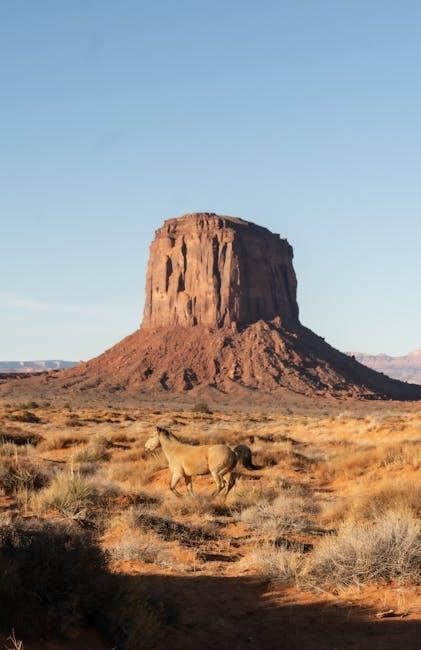A Quit Claim Deed Arizona PDF is a legal document transferring property ownership without title warranty, ideal for simple transfers between family or resolving title disputes.
1.1 Overview of Quit Claim Deeds in Arizona
A Quit Claim Deed in Arizona is a legal document that transfers ownership of real property without guaranteeing the grantor’s title is clear. It conveys only the grantor’s interest in the property, making it ideal for simple transfers, such as between family members or in divorce settlements. This type of deed is recognized under Arizona law and is often used to resolve title disputes or transfer property quickly. It provides no warranties, so the grantee assumes potential risks associated with the property’s title.
1.2 Importance of Using a Quit Claim Deed PDF
Using a Quit Claim Deed PDF in Arizona is essential for legally transferring property ownership without title warranties; It provides a straightforward and cost-effective method for simple transfers, such as between family members or in divorce settlements. The PDF format ensures accessibility and ease of use, allowing parties to fill out and print the document efficiently. It is a recognized legal document under Arizona law, making it a reliable choice for resolving title disputes or transferring property quickly and effectively.

Legal Requirements for a Quit Claim Deed in Arizona
A Quit Claim Deed in Arizona requires the grantor’s and grantee’s names, property description, deed date, and a notarized grantor signature to ensure legal validity.
2.1 Names and Addresses of Grantor and Grantee
The Quit Claim Deed must include the full legal names and complete addresses of both the grantor (current owner) and the grantee (new owner). This ensures clarity and proper identification. The grantor’s signature must be notarized, while the grantee’s signature is not required. Accurate details are crucial for legal validity and smooth property transfer. This information helps avoid disputes and ensures the deed is properly recorded in Arizona county records.
2.2 Legal Description of the Property
The legal description of the property is essential for identifying the specific land being transferred. It must include detailed information such as lot numbers, block numbers, and subdivision names, as recorded in county records. This description ensures clarity and prevents disputes. The property’s location and boundaries are precisely defined, often referencing the Assessor’s Parcel Number (APN) for accuracy. A correct legal description is critical for the deed’s validity and proper recording with the county recorder.
2.3 Date of the Deed
The date of the deed is a required element, typically placed at the top of the document. It indicates when the transfer of ownership is officially recognized. The date must be accurate and reflect the time of the grantor’s signature. This detail is crucial for record-keeping and establishing the timeline of the property transfer. The deed’s date also helps in determining the effective date of ownership change, which is essential for legal and administrative purposes.
2.4 Notarized Signature from the Grantor
A notarized signature from the grantor is a legal requirement for a valid quit claim deed in Arizona. This ensures the grantor’s identity and voluntary consent to the transfer. A notary public witnesses the signing and verifies the grantor’s authenticity. The notarization process involves the notary stamp or seal, confirming the document’s legitimacy. Without this step, the deed may be deemed invalid or rejected by the county recorder, making it essential for the transfer’s legal recognition.

The Process of Creating a Quit Claim Deed in Arizona
Creating a quit claim deed involves drafting the document, ensuring notarization, and recording it with the county recorder to finalize the property transfer legally.
3.1 Drafting the Deed
Drafting a quit claim deed in Arizona requires including essential details such as the grantor’s and grantee’s full names and addresses, a precise legal description of the property, and the deed date. The document must also contain a statement that the grantor transfers all interest in the property without warranties. The grantor’s signature must be notarized to ensure authenticity. Accuracy is crucial to avoid legal issues, so using a template or consulting a legal expert is recommended.
The deed should clearly outline the transfer of ownership, ensuring compliance with Arizona state laws. Proper formatting and language are necessary to maintain the document’s validity. Including any additional clauses or conditions, if applicable, should be done carefully to reflect the intended transfer accurately.
3.2 Notarization Requirements
The grantor’s signature on a quit claim deed in Arizona must be notarized to validate the document. A notary public verifies the grantor’s identity and witnesses the signing, ensuring the deed’s authenticity. This step is legally required to prevent fraud and confirm the grantor’s voluntary consent. Proper notarization involves the notary stamp, signature, and date, making the deed legally binding. Without notarization, the document may be deemed invalid in court or county records.
Ensure the notary adheres to Arizona state laws and procedures for authenticating signatures.
3.3 Recording the Deed with the County Recorder
After notarization, the quit claim deed must be recorded with the appropriate Arizona county recorder’s office. This step ensures the transfer is publicly documented and provides legal notice of ownership change. The recorder maintains property records, verifying the deed’s authenticity and date. Failure to record the deed can lead to legal disputes or delays in resolving title issues. Recording fees apply, and the process typically includes submitting the original notarized document for filing.
Timely recording is crucial for protecting both parties’ interests.

Advantages and Disadvantages of a Quit Claim Deed
A quit claim deed offers simplicity and cost-effectiveness for transferring property, ideal for straightforward transactions. However, it lacks title warranty, posing risks for the grantee.
4.1 Advantages of Using a Quit Claim Deed
A quit claim deed is a simple and cost-effective way to transfer property ownership, ideal for non-sale transactions like gifts or transfers between family members. It avoids the need for title insurance, making the process faster and less expensive. Additionally, it helps resolve title disputes or clear title issues without legal complications. This deed is particularly useful in divorce settlements or when transferring property to a trust, ensuring a smooth and efficient process.
4.2 Disadvantages of Using a Quit Claim Deed
A quit claim deed offers no title warranty, meaning the grantor doesn’t guarantee the property is free of liens or disputes. This can leave the grantee vulnerable to hidden issues. It’s unsuitable for sales to third parties, as buyers may prefer a warranty deed for protection. Additionally, the grantor remains liable for any undiscovered claims against the property. Its simplicity can lead to legal complications if not executed properly, making it less secure for complex transactions.
Common Uses of a Quit Claim Deed in Arizona
A quit claim deed is often used for transferring property between family members, resolving divorce settlements, or clearing title issues without guaranteeing a clean title.
5.1 Transferring Property Between Family Members
A quit claim deed is frequently used to transfer property between family members, such as from parents to children or between siblings. This method is ideal for intra-family transfers as it simplifies the process without requiring a full title search. It allows for the quick conveyance of ownership while avoiding legal disputes. However, it’s important to note that the deed does not guarantee a clear title, so the grantee assumes any potential risks associated with the property’s history.
5.2 Divorce Settlements and Property Division
A quit claim deed is often used in divorce settlements to transfer property ownership between spouses. It allows one party to relinquish their interest in the property quickly, making it a practical solution for dividing assets. This method is particularly useful when one spouse wants to transfer their share to the other without guaranteeing title clarity. It simplifies the process, avoiding complex legal disputes and ensuring a swift resolution to property division in divorce cases.

5.3 Clearing Title Issues
A quit claim deed is often used to clear title issues in Arizona, providing a quick way to resolve ownership disputes. It allows the grantor to transfer any interest they hold without guaranteeing a clear title. This method is particularly useful for resolving liens, unknown claims, or conflicting interests. However, it’s important to note that the grantee assumes all title risks. Consulting a legal expert is recommended to ensure this method suits the situation.
How to Fill Out a Quit Claim Deed Arizona PDF
Fill in the grantor and grantee names, property description, and execution date. Ensure the grantor’s signature is notarized. Attach any required documentation for accuracy.
6.1 Step-by-Step Guide to Completing the Form
Enter the grantor and grantee names, property description, and execution date. Include the legal description of the property, ensuring accuracy. Sign the deed as the grantor and have it notarized. Attach any additional documentation required for clarity. Review the form for errors before submission to ensure all details are correct and complete. This process ensures the deed is legally valid and properly executed in Arizona.
6.2 Ensuring Accuracy in the Legal Description
Accurately describing the property is crucial for the deed’s validity. Include the Assessor’s Parcel Identification Number (APIN) and a detailed legal description, referencing county records. Verify boundaries, lot numbers, and street addresses to avoid disputes. Cross-reference with official documents to ensure precision. Errors in the legal description can lead to title issues or invalidation of the deed. Consulting a professional may be necessary for complex properties to guarantee accuracy and compliance with Arizona legal standards.

Where to Find a Quit Claim Deed Arizona PDF
Access Arizona quit claim deed PDFs through online platforms like pdfFiller or official county recorder websites, ensuring a reliable and efficient document retrieval process.

7.1 Online Sources for the PDF Form
Online platforms like pdfFiller and official Arizona county websites offer downloadable quit claim deed PDF forms. These sources provide fillable templates, ensuring legal compliance and ease of use. Users can access attorney-drafted documents, fill them online, and print or download for execution. Additionally, websites like PrintFriendly offer free PDF versions tailored for Arizona property transfers. These online resources streamline the process, making it convenient to obtain and complete the necessary forms efficiently.
7.2 County Recorder or Local Government Offices
Arizona County Recorder offices provide official quit claim deed forms, ensuring compliance with state laws. Visit local government websites or offices to access authentic templates. For example, the Arizona County Recorder website offers downloadable PDFs, while offices like the Maricopa County Assessor provide detailed forms. These sources guarantee accuracy and adherence to legal standards, making them reliable for property transfers. In-person visits or official website downloads are recommended for the most up-to-date and valid documents.
Differences Between Quit Claim Deed and Warranty Deed
A quit claim deed transfers the grantor’s interest without title warranties, while a warranty deed guarantees clear ownership and title, offering the grantee more protection.
8.1 Title Warranty in Warranty Deeds
A warranty deed provides a title warranty, ensuring the grantor has clear ownership and the property is free from liens or encumbrances. It guarantees the grantor’s legal right to sell and protects the grantee from future title disputes. This comprehensive warranty makes it a safer choice for buyers, especially in real estate transactions involving third parties. The grantor is legally obligated to defend the title against claims, offering the grantee long-term security and peace of mind.
8.2 No Title Warranty in Quit Claim Deeds
A quit claim deed does not provide any title warranty, meaning the grantor does not guarantee the title’s validity or clarity. It transfers only the grantor’s current interest in the property, making the grantee responsible for any hidden issues or liens. This lack of warranty increases the risk for the grantee, as they may inherit title defects. It is often used in low-risk transactions, such as transfers between family members or to resolve title disputes, but the grantee may need additional insurance or legal advice to mitigate risks.
Legal Implications of Using a Quit Claim Deed
Using a quit claim deed transfers property without title warranty, making the grantee responsible for any hidden issues. Legal risks include potential title defects or unresolved liens.
9.1 Potential Risks for the Grantee
A grantee using a quit claim deed in Arizona assumes all risks, as the deed provides no warranty of title. This means the grantee may inherit hidden liens, title defects, or unresolved claims. If issues arise, the grantee bears the cost of resolving them, potentially leading to financial loss. The lack of guarantees makes it crucial for the grantee to conduct thorough title research before accepting the transfer to avoid unforeseen legal or monetary consequences.
9.2 Liability for the Grantor
The grantor in a quit claim deed in Arizona is not absolved of all liability. While the deed transfers ownership without warranties, the grantor must still ensure they have the legal right to convey the property. If the grantor knowingly transfers fraudulent or invalid title, they may face legal consequences, including claims of fraud or misrepresentation. The grantor remains liable for any debts or liens on the property unless explicitly released by the grantee or settled prior to the transfer.
When Not to Use a Quit Claim Deed
Avoid using a quit claim deed for third-party sales or when transferring property with unknown liens, as it offers no title warranty, risking legal disputes.
10.1 Selling Property to a Third Party
A quit claim deed is not suitable for selling property to a third party, as it provides no title warranty, leaving the buyer unprotected against potential claims or liens. Third parties typically require assurance of clear ownership, which a quit claim deed does not offer. Using a warranty deed is preferable in such transactions, as it ensures the seller guarantees the title’s validity, reducing legal risks for the buyer and facilitating smoother real estate transactions.
10.2 Transferring Property with Unknown Liens
Using a quit claim deed to transfer property with unknown liens is risky, as it offers no protection for the grantee. Unknown liens or encumbrances on the property remain the grantee’s responsibility, potentially leading to financial or legal issues. A warranty deed is more appropriate in such cases, as it provides assurances against hidden claims. Transferring property with unknown liens via a quit claim deed exposes the buyer to unforeseen liabilities, making it a less secure option for both parties involved in the transaction.

Tax Implications of a Quit Claim Deed in Arizona
A quit claim deed in Arizona may have tax implications, including property taxes and potential gift tax considerations, depending on the transfer’s nature and value.
11.1 Property Taxes After Transfer
After transferring property via a quit claim deed in Arizona, the new owner becomes responsible for property taxes. The tax assessor’s office is typically notified of the ownership change. Property taxes are based on the property’s assessed value, and the transfer may trigger a reassessment. The grantee should verify tax obligations to avoid penalties. The tax implications vary depending on the property’s use and the transfer’s nature, such as gifts or sales.
11.2 Gift Tax Considerations
When using a quit claim deed in Arizona for gifting property, the grantor may face federal gift tax implications if the property’s value exceeds the annual exclusion limit. Arizona does not impose a state gift tax, but the grantor must still report the transfer to the IRS. The grantee typically does not incur tax liability but should be aware of the property’s tax basis, which may impact future transactions. Consulting a tax professional is advisable to navigate these considerations effectively.
Role of an Attorney in Quit Claim Deed Process
An attorney ensures the quit claim deed is legally sound, represents parties’ interests, and provides guidance on Arizona property laws and potential legal implications.
12.1 When to Consult a Real Estate Attorney
Consult a real estate attorney when dealing with complex title issues, disputes, or unclear property rights. They ensure the quit claim deed is legally valid and complies with Arizona laws, preventing future disputes. Attorneys are especially crucial in cases involving multiple parties, significant financial stakes, or potential liabilities. Their expertise helps navigate legal intricacies, protecting both grantor and grantee interests effectively.
12.2 Benefits of Legal Representation
Legal representation ensures the quit claim deed is executed correctly, complying with Arizona laws and preventing future disputes. An attorney verifies the deed’s validity, protecting both parties’ interests. They handle complex issues like title defects or liens, ensuring a smooth transfer. Legal advice provides peace of mind, safeguarding against potential legal pitfalls and ensuring all rights are preserved. Proper representation is invaluable for securing a clear and enforceable property transfer.
A quit claim deed Arizona PDF simplifies property transfers without title guarantees, ideal for straightforward transactions. Proper execution ensures legal compliance, protecting both parties’ interests effectively.
13.1 Final Thoughts on Using a Quit Claim Deed in Arizona
A quit claim deed in Arizona offers a straightforward method for transferring property ownership, particularly in uncomplicated scenarios like family transfers or resolving title disputes. While it lacks title warranties, its simplicity and efficiency make it a valuable tool for specific situations. Proper execution, including notarization and recording, is essential to ensure legal validity. Consulting a real estate attorney can help navigate potential risks and ensure compliance with Arizona laws. This document is ideal for those seeking a cost-effective, no-frills solution for property transfers.
13.2 Importance of Proper Execution
Proper execution of a quit claim deed in Arizona is crucial for its validity and enforceability. Ensuring all legal requirements, such as notarization and accurate property descriptions, prevents future disputes. Recording the deed with the county recorder is essential to provide public notice of the transfer. Failure to execute the deed correctly can lead to legal challenges or an invalid transfer. Consulting a real estate attorney helps guarantee compliance with Arizona laws and avoids potential pitfalls.

Additional Resources
Additional resources include Arizona County Recorder websites for forms and legal aid societies for guidance, ensuring accurate and compliant document preparation and execution.
14.1 Arizona County Recorder Websites
Arizona County Recorder websites provide access to official forms, including the Quit Claim Deed Arizona PDF. These sites offer detailed instructions, legal descriptions, and recording requirements. Counties like Maricopa and Pima provide downloadable templates and guidelines to ensure compliance with state laws. Using these resources helps individuals accurately complete and file their deeds, avoiding legal issues. They are essential for anyone preparing a quit claim deed in Arizona.

14.2 Legal Aid and Real Estate Associations
Legal aid organizations and real estate associations in Arizona offer resources and guidance for completing a Quit Claim Deed Arizona PDF. These groups provide templates, legal advice, and workshops to help individuals understand the process. They often collaborate with attorneys to ensure documents are executed correctly. Many associations, such as the Arizona Bar Association, offer affordable services or referrals to professionals. Their support helps individuals navigate the complexities of property transfers and avoid potential legal pitfalls.
